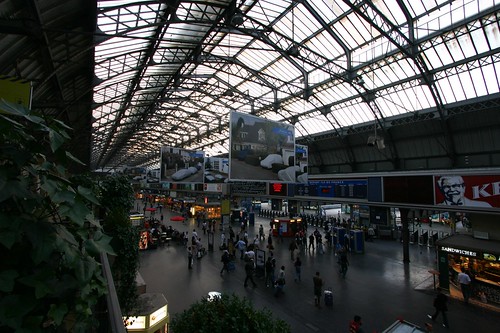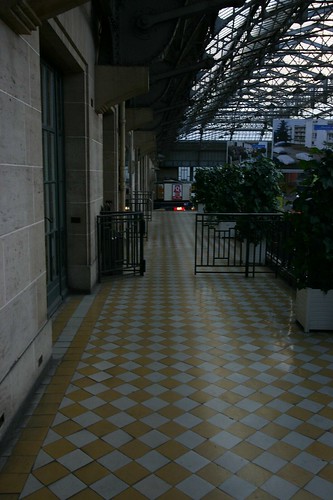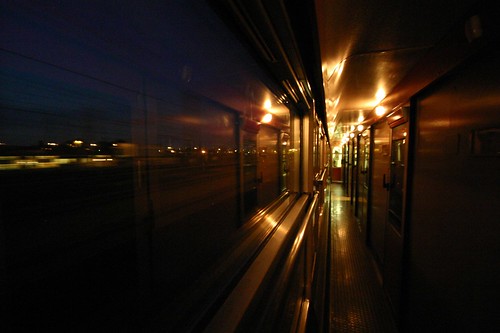The Null Device
Posts matching tags 'paris'
2012/2/4
There's a new article in WIRED interviewing members of the French underground explorers/guerilla repairers/real-life troglodistes UX; i.e., the people who set up a secret, fully outfitted cinema in the Parisian catacombs and subsequently covertly repared the clock in the Panthéon (and then made the mistake of notifying the officials responsible for the building, who deliberately broke it again out of spite); this article, largely drawn from an interview with one Lazar Kunstmann, has some details about the origins of the movement, its motivations, and some of its techniques:
Thirty years ago, in the dead of night, a group of six Parisian teenagers pulled off what would prove to be a fateful theft. They met up at a small cafè near the Eiffel Tower to review their plans—again—before heading out into the dark. Lifting a grate from the street, they descended a ladder to a tunnel, an unlit concrete passageway carrying a cable off into the void. They followed the cable to its source: the basement of the ministry of telecommunications. Horizontal bars blocked their way, but the skinny teens all managed to wedge themselves through and ascend to the building’s ground floor. There they found three key rings in the security office and a logbook indicating that the guards were on their rounds. But the guards were nowhere to be seen. The six interlopers combed the building for hours, encountering no one, until they found what they were looking for at the bottom of a desk drawer—maps of the ministry’s citywide network of tunnels. They took one copy of each map, then returned the keys to the security office.
In some places, UX has been able to create covert connections between networks, using (among other tricks) an invention they call the rolling basin. This is a passage in the bottom of a tunnel that appears to be a grate with water under it; in fact, both grate and water are part of a movable tray on rollers. Voilà trapdoor to another tunnel in a different network. The tray itself is made of concrete, so even if someone raps it with a stick, it sounds solid.
So what does the group do with all this access? Among other things, it has mounted numerous clandestine theater productions and film festivals. On a typical festival evening, they screen at least two films that they feel share a nonobvious yet provocative connection. They don’t explain the connection, leaving it up to the audience to try to discover it. One summer, the group mounted a film festival devoted to the theme of “urban deserts”—the forgotten and underutilized spaces in a city. They naturally decided the ideal venue for such a festival would be in just such an abandoned site.Kunstmann has some quite scathing words about the officials notionally responsible for the preservation of France's historical and cultural patrimony, a duty which UX claim they've derelicted:
Kunstmann has a gloomy view of contemporary civilization, and in his eyes this affair illustrates many of its worst faults—its fatalism, complacency, ignorance, parochialism, and negligence. French officials, he says, bother to protect and restore only the patrimony adored by millions—the Louvre, for example. Lesser-known sites are neglected, and if they happen to be out of public view—underground, say—they disintegrate totally, even when all that’s needed is a hundred-dollar leak repair. UX tends the black sheep: the odd, the unloved, the forgotten artifacts of French civilization.
It seems that the problem is exacerbated by a culture of officiousness endemic to France's public service, where the purpose of an office is often overshadowed by the ego of the holder of the office and his (or hers, though, to be honest, usually his) need to stake out turf and engage in territorial pissing matches. Hence the neglect of anything not immediately prestigious and the active hostility to those who show up said official neglect by doing something about it.
UX have learned their lesson from the Panthéon incident; since then, they claim to have repaired some 15 other sites, though have kept the details secret:
I ask him to elaborate on their choice of projects. “We can say very little,” he replies, “because to describe the sites even a bit can give away their location.” That said, one site is “belowground, in the south of Paris, not very far from here. It was discovered relatively recently but elicited very strong interest. It totally contradicts the history of the building above it. In examining what’s belowground, one notices that it doesn’t correspond to the information one can obtain about the history of the site. It’s history in reverse, in a way; the site was dedicated to an activity, structures were placed there, but in fact the site had been dedicated to this activity for quite a long time.”
2011/1/3
Sleepy City is a website run by someone who (a) is a very good photographer and (b) enjoys sneaking illicitly into underground railway tunnels, drainage systems, abandoned buildings and the like, illegally taking gorgeous photographs and posting them online. Most recently, they posted an epic feature on the Paris Métro, complete with some fantastic photographs:
Other galleries on the site include the tunnels (Underground and other) beneath London, explorations in the US, Russia and Japan, and a few evocative galleries from abandoned mental hospitals (always a good topic):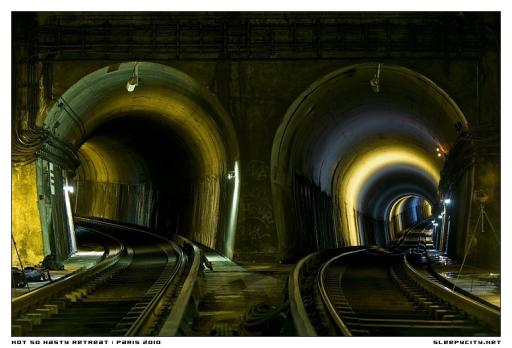
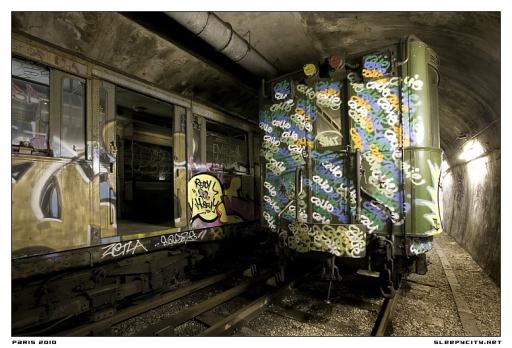
(via Boing Boing) ¶ 0
2010/6/29
An interesting piece by Financial Times writer Simon Kuper on the cultural impact of Eurostar; how the cross-channel train service between London and Paris (Brussels doesn't rate a mention) has transformed the cultures of both cities; before, things used to be much different:
Until the 1990s, To Britons Paris seemed almost as exotic as Jakarta, and more so than Sydney or San Francisco. There was that famous smell of the French Métro, the mix of perfume and Gauloises cigarettes. There was the bizarre sight of people drinking wine on pavements. There was all that philosophy. The exoticism of Paris became such a staple of English-language writing that comedians began to parody it. “I come upon a man at an outdoor café,” writes Woody Allen. “It is André Malraux. Oddly, he thinks that I am André Malraux.”
Those first trains connected two fairly insular cities. I had returned to Britain from Boston the summer before the Eurostar was launched, and after the Technicolor US, I was shocked by dingy London. Tired people in grey clothes waited eternities on packed platforms for 1950s Tube trains. Coffee was an exotic drink that barely existed, like ambrosia. Having a meal outside was illegal. The city centre was uninhabited, and closed at 11pm anyway. Air travel was heavily regulated, and so flying to Paris was expensive. Going by ferry took a whole miserable day. If you did get across, and only spoke the bad French most of us learnt at school, it was hard to communicate with any natives.Now, London and Paris have converged somewhat; London has shaken off some of its Anglo-Saxon austerity and embraced a more Continental lifestyle, with outdoor bdining, late-closing bars and gourmet food markets, and even got a taste for French-style grands projets, not least of all St. Pancras International, the Eurostar terminus. (As for coffee, I can only imagine that, before 1994 or so, anyone requesting coffee rather than tea would be met with a mug of Nescafé Blend 43 or similar.) Meanwhile, Paris has shed some of its Gallic hauteur and become more London-like:
But with the inventions of the internet and Eurostar, and globalisation in general, many Parisians began to see that there was a wonderful new life to be seized if you spoke English. Paris could choose to become an inhabited museum, a sort of chilly Rome, but if it wanted to remain in touch with the latest ideas, the Parisian establishment would have to learn English. By and large, the younger members did. The canard that Parisians refuse to speak English is a decade out of date. As I write, every car on the street outside my office is festooned with a flyer for English lessons for children. Parisian parents are now so keen to induct their toddlers into the global language that speaking English has become a weapon for us Anglophone parents in the battle for a spot in a crèche.Of course, some differences remain (French children are apparently quieter and cleaner than the mowfy brats of Britain, while Britons dress more colourfully, in "weird youth-culture outfits"), but they're becoming less distinct, as more people commute or travel between the two cities. (London is apparently now, by population, the sixth-largest French city.)
Kuper goes on to describe a bright future for western Europe, largely due to its compact geography, further amplified by the promise of high-speed rail. Indeed, shiny, aerodynamic high-speed trains seem to be the unchallenged future of travel, with air travel, that darling of the 1990s, looking a bit shabby, between rising oil prices, the Long Siege and things like the Icelandic volcanic ash cloud.
In Paris, fare evaders on the Métro have organised into outlaw insurance societies. The mutuelles des fraudeurs take a monthly fee of somewhere around 7 euros, and in turn offer to pay the fraudsters' fines, should they get caught. They also compile databases of fare-evading tips and encourage those who would otherwise be too timid.
Back in 2001 or so, he and a group of fellow travelers, in both the literal and metaphorical senses, formed the Network for the Abolition of Paid Transport, "the beginning of our struggle," Gildas calls it. The group's initials in French mimic those of the agency that runs the Metro and buses, and to the agency's logo, which looks like the outline of a face, abolitionists added a raised fist.The mutuelles claim justification, oddly enough, from left-wing ideology. Defrauding the Métro of ticket revenue is not an act of individual greed, you see, but a collective blow against capitalism. It's true that the Paris Métro may not be run for profit as public transport systems in the Anglosphere tend to be, but such trivialities are of no matter when issues of sweeping ideology are at stake. The Métro, they contend, should be free to ride, with the €8bn or so it costs to run each year being paid for by expropriating the rich. (What they'll do when the rich have all been expropriated, or have fled to Russia or Dubai or a floating Galtian utopia on the high seas, they do not explain; nor do they explain how they'll prevent a free, ungated public transport system turning into an expensive homeless shelter, driving away those passengers who have a choice of where to go.) No, they're striking a blow against the fascist regime that is the RATP, and helping to bring forward the advent of the Another World that Is Possible. And, quite probably, breaking the law; insurance against penalties for unlawful acts is generally frowned upon.
(It occurred to me that, were something like the mutuelles des fraudeurs to arise in the English-speaking world, it'd be couched in the language of free-market libertarianism rather than macaronic pseudo-socialism. Rather than attempting to sell a nebulous collective solidarity, it'd speak out to the individual in the language of self-improvement and competition, imploring them to be a winner and not a loser (like the chumps who pay full fare), and would defend itself as the invisible hand of the free market providing a service and/or striking a blow against socialism.)
2010/6/13
Data visualisation of the day: Locals and Tourists. Location data was harvested from geotagged photos on Flickr and plotted on maps; the points were colour-coded: blue if the poster was a local (i.e., had been in the city for more than a period of time), red if they were tourists (recent visitors with no prior history), and yellow if it was ambiguous. Here, for example, is London, with the Thames and the West End ablaze with red and the East End blue (which means that there are fewer tourists but still plenty of photographers, think Hackney art hipsters and/or kids with iPhones):
And here are Paris; tourists flock to the obvious parts (the Eiffel Tower, the Champs-Elysees, the Seine and the Île-de-Cité), whereas the locals who tend to post photos gravitate to the east, around the Bastille and such; the affluent, conservative southern arrondisements are largely a wasteland, photographically at least. In Berlin, meanwhile, tourists fill the city's broad central boulevards, the Tiergarten and Alexanderplatz and Karl-Marx-Allee, and visit the East Side Gallery, but there's a lot of local photography happening around Kreuzberg/Neukolln.
In fact, one could use the frequency of non-tourist photography for an area as a predictor of cultural vibrancy. Areas where a lot of photos are taken by people who live in the same city and not by tourists could be the kinds of broad areas where local scenes form, and the kinds of people who engage in cultural activity beyond passive consumption (sometimes referred to as "hipsters") are more likely to be found. This is borne out by other maps: Melbourne (there are specks of blue around the inner north, while the sprawling suburbs are largely empty). In New York, meanwhile, Manhattan glows with tourist activity but Brooklyn is veined with blue.
Of course, the amount of blue space on these maps is considerably larger than any nexus of cultural activity would be; it'd cover the areas where events take place, where the participants live and work, and spaces in between. However, it does make one wonder whether one could data-mine the buzz of a city by correlating Flickr photo geodata or other indices of participation with other data; possibly transport routes?
2009/2/10
Paris's pioneering Vélib cycle rental scheme is under threat after it emerged that more than half of the bicycles have been stolen or destroyed, with more having been vandalised, and a few having been subjected to more surrealistic interventions:
Hung from lamp posts, dumped in the River Seine, torched and broken into pieces, maintaining the network is proving expensive. Some have turned up in eastern Europe and Africa, according to press reports.
The Velib bikes - the name is a contraction of velo (cycle) and liberte (freedom) - have also fallen victim to a craze known as "velib extreme". Various videos have appeared on YouTube showing riders taking the bikes down the steps in Montmartre, into metro stations and being tested on BMX courses.
Not all the bicycles receive rough treatment however. One velib repairman reported finding one of the bikes customised with fur covered tyres.
2007/11/27
The UX, the secretive Parisian underground exploration group which built an underground cinema in the city's labyrinthian catacombs, pulled off an even more impressive feat last year: breaking into the Panthéon and surreptitiously repairing its clock, all without the authorities knowing about it:
Getting into the building was the easiest part, according to Klausmann. The squad allowed themselves to be locked into the Panthéon one night, and then identified a side entrance near some stairs leading up to their future hiding place. "Opening a lock is the easiest thing for a clockmaker," said Klausmann. From then on, they sneaked in day or night under the unsuspecting noses of the Panthéon's officials.
The hardest part of the scheme was carrying up the planks used to make chairs and tables to furnish the Untergunther's cosy squat cum workshop, which has sweeping views over Paris.
The group managed to connect the hideaway to the electricity grid and install a computer connected to the net.Neither the Panthéon's staff nor the authorities noticed anything until the UX's surreptitious restoration cell, the Untergunther, notified them of what they had done. The officials, being officials, didn't appreciate the act; the administrator of the Panthéon was sacked, and the state initiated legal action against the restorers. The group has recently been cleared of any wrongdoing, and is working on another secret restoration mission.
But the UX, the name of Untergunther's parent organisation, is a finely tuned organisation. It has around 150 members and is divided into separate groups, which specialise in different activities ranging from getting into buildings after dark to setting up cultural events. Untergunther is the restoration cell of the network.
Members know Paris intimately. Many of them were students in the Latin Quarter in the 80s and 90s, when it was popular to have secret parties in Paris's network of tunnels. They have now grown up and become nurses or lawyers, but still have a taste for the capital's underworld, and they now have more than just partying on their mind.And here and here is more about the UX and Untergunther. (It is not clear how these groups are related to "La Mexicaine de Perforation", the group credited with the underground cinema uncovered in 2004.)
I wonder how much of an inspiration those secret catacomb parties of the 1980s were on the characters of the "troglodistes", the sewer-dwelling guerilla frogmen in Jeunet and Caro's film Delicatessen.
(via Boing Boing) ¶ 2
2007/7/2
A few videos from this weekend's Momus gig at La Flèche d'Or in Paris:
Pierrot Lunaire:
Nervous Heartbeat:
2006/12/21
Culture-bound syndrome of the day: "Paris Syndrome". This is a condition affecting Japanese tourists who travel to Paris, romantic scenes from Amélie in their minds, only to discover that the city is considerably dirtier and—shock, horror—full of very rude people. This shock can cause a psychiatric breakdown:
An encounter with a rude taxi driver, or a Parisian waiter who shouts at customers who cannot speak fluent French, might be laughed off by those from other Western cultures.
But for the Japanese - used to a more polite and helpful society in which voices are rarely raised in anger - the experience of their dream city turning into a nightmare can simply be too much.
This year alone, the Japanese embassy in Paris has had to repatriate four people with a doctor or nurse on board the plane to help them get over the shock.As many as 12 Japanese tourists fall victim to Paris Syndrome each year. The Japanese embassy has established a 24-hour hotline to help those afflicted.
2006/6/21
I'm back in London now, having spent the past five days on the continent, catching the Eurostar to Paris, then travelling via Zürich to Tuscany, staying for a few days in the mediaeval hilltop town of Cetona, then back to Paris via Florence and back to London. Photos from my travels will gradually filter onto Flickr.
Some observations:
- The Eurostar train to Paris was delayed by 80 minutes; it seems that the tunnel wasn't feeling well or something, and the train had to wait outside whilst its handlers coaxed it into cooperating. Consequently, I missed my initial connection, the 19:06 sleeper to Florence, despite a white-knuckle taxi ride through the Parisian rush-hour traffic. The moral of this story: allow more than one hour and 40 minutes between the Eurostar and anything departing from Gare de Bercy.
- I did manage to get a bunk on a later sleeper to Zürich, and a connecting train to Milan. The Zürich train (a French SNCF service) was relatively empty, and even in second class, quite comfortable.
- The Swiss love their sans serif typefaces and clean design, and have some of the best-looking banknotes I have seen. They're about as colourful as Australian banknotes, only with more of a modernist European graphic-design feel.
- The journey through the Swiss Alps from Zürich to Milan is probably the most scenic railway journey I have been on; the train climbs into the alps, winding around hills and going through tunnels, passing vast, mirror-still lakes and small towns. Then it goes through a tunnel near St. Gotthard's Pass, and comes out in the Italian-speaking part of Switzerland, which has a completely different climate, geography, architecture and character, seeming rather Mediterranean. I have added Switzerland to the list of places to visit.
- Swiss trains are very clean and run like clockwork. Italian trains are generally of a high standard. The "EuroStar Italia" trains (which are similar to French TGVs or Virgin Pendolinos) are fast and come with an onboard magazine (in Italian) and radio channels in the seats (which didn't seem to be working), and the "InterCity" trains (expresses pulled by more conventional electric locomotives; virtually all railways in Europe are electric these days) are air conditioned and clean. First class on those costs slightly more than second-class and gives you larger-looking seats (though they have the same number of them in the compartments) and power points near the window seats. (The EuroStar to Paris also had power points (European ones, not British ones), though the returning one didn't.)
- The "Palatino" sleeper from Florence to Paris is quite popular, and consequently the compartment I was in was full. Fitting into a second-class sleeper compartment (which holds six) with baggage is a bit of a juggling act. Apparently first class sleepers are said to be much more comfortable.
- Most if not all of the native English speakers one meets whilst travelling on trains through Europe are Americans. I wonder why this is; perhaps it's because Britons associate trains with day-to-day drudgery and avoid them whilst on holidays, whereas Americans regard them as part of the European experience.
2006/6/18
Your humble correspondent is currently on the Continent, and hence blogging has been somewhat light. However, here are a few photographs from my journey so far, whilst passing through France:
The first thing one sees upon emerging at the French end of the Channel tunnel on the Eurostar:

A Paris Métro ticket repurposed into street art:
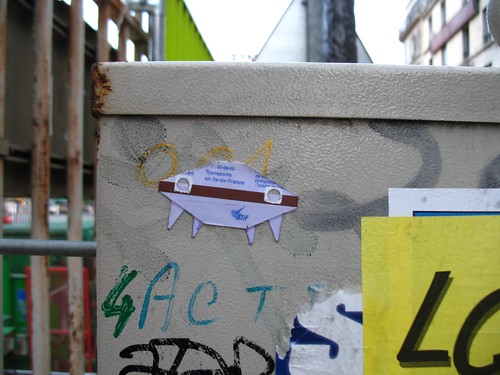
Early evening outside the Gare de l'Est, Paris.
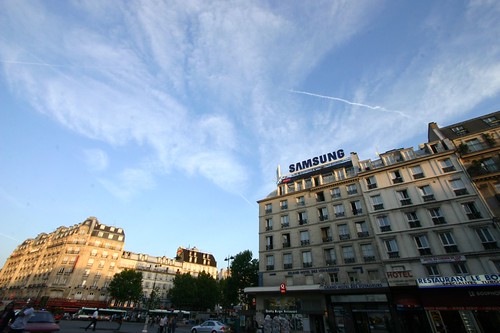
The sleeper train to Zürich, Gare de l'Est, Paris:
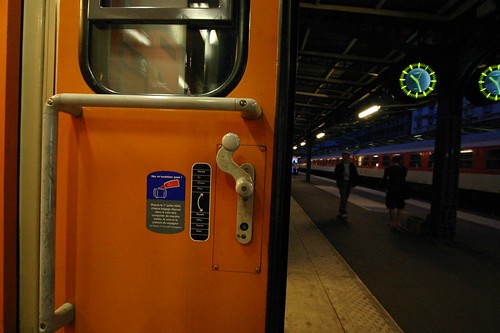
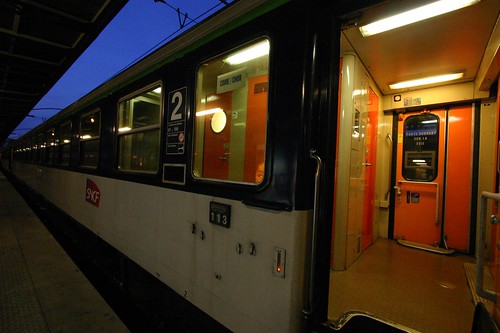
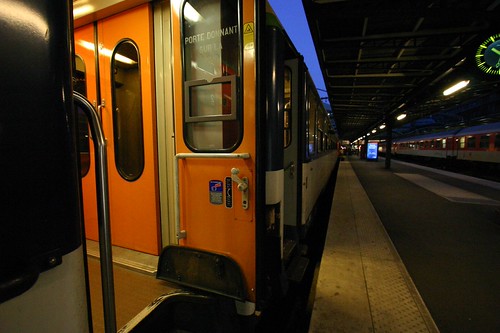
My compartment for the night on the Paris-Zürich sleeper (2nd class):
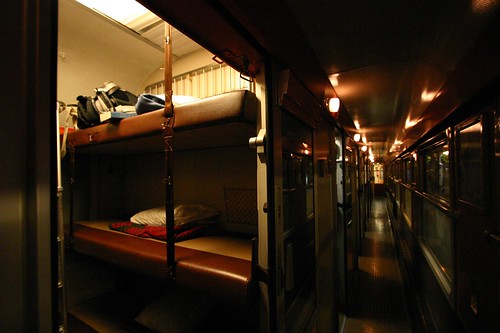
2006/3/5
The latest cinematic art movement in Paris is the "pocket film" movement, which involves footage shot spontaneously on mobile phones and edited into short films, of which there was a festival last year:
Pocket movies are often intimate and engaging, and because mobile phones can go anywhere the camera gets a licence to roam. You can film on a bike, or shoot the rush-hour crush; one director has even filmed herself voting.
Film director Jean-Claude Taki says: "These days the process is more after the fact. By that I mean that we don't make out a storyboard and organise the filming beforehand, but we start with the filming which is something which becomes part of your life that you do whenever you want, then we edit. And all the time you can film stuff for the edit and that's how the film is constructed."The web site of last year's Pocket Films festival is here; there is a selection of films here (in streaming Flash). They vary from raw phone footage, some with overdubbed sound or music, to more elaborately edited works which use footage shot on mobile phones. Some of them tell simple stories, and some of them look not a world away from the sorts of things shot by artists with 8MM cameras in decades past, which one can find screened at film nights in inner-city bars.
2005/10/4
A new art exhibit is causing controversy in Paris; the Plancher de Jeannot (Jeannot's Floorboards) consists of the floor of a Pyreneean farmhouse, into which its schizophrenic inhabitant carved increasingly disturbed rants:
Jeannot moved his bed to the dining room, next to the stairs, and began carving the oak floor: 'Religion has invented machines for commanding the brain of people and animals and with an invention for seeing our vision through the retina uses us to do ill (...) the church after using Hitler to kill the Jews wanted to invent a trial to take power (...) we Jean Paule are innocent we have neither killed nor destroyed nor hurt others it's religion that uses electronic machines to command the brain.'The Plancher de Jeannot have gone on display at the Bibliotheque François Mitterrand in Paris, amidst much controversy; once the exhibition is finished, they will be donated to a psychiatric hospital in Paris. Some photographs are here amd here.
(via ![]() substitute) ¶ 0
substitute) ¶ 0
2005/2/3
The privatisation of the space of concepts keeps marching on; now, it turns out likenesses of the Eiffel Tower are copyrighted, and cannot be published without a licence. The city of Paris and the company which maintains the tower managed to do this by adorning it with a distinctive lighting display, which they then copyrighted; consequently, any recent night-time photograph of the Eiffel Tower is a derivative work. In their infinite generosity, they have said that they are not interested in going after amateurs putting holiday photographs of the tower on their web sites; they are, however, technically in violation. Which means that this WikiMedia image is technically in violation. And so, the space of free public discourse narrows slightly.
I wonder what's next: perhaps Ken Livingstone will copyright the names of London Underground lines and stations and demand licensing fees from fiction authors who mention them or something?
Eventually, we will get to the situation where all real-world objects and likenesses are intellectual property and use of them requires licensing fees. (After all, the dominant Reaganite/Thatcherite ideology of our time says that the way to maximise the efficient use of any resource is to monetise it and place it on the market; coupled with intellectual property, the natural conclusion is what Lawrence Lessig calls an "if-value-then-right" intellectual property regime, where for any value in an item, there is a right assigned to a rightsholder, who can license that right on the open market. Think of the colossal economic waste we had in the bad old days of the public domain and Jeffersonian copyrights.) As depicting any public figure, fictional character, location or privatised folklore will require a licence, costing fees and giving rightsholders vetoes over works they find objectionable, stories (well, those without the corporate media backing required to resolve all the rights issues) will move to generic locations; nameless, nondescript buildings, cities, countries and characters will take hold. To which, Big Copyright will respond by copyrighting categories of ideas (in the way that Marvel and DC Comics claimed a joint trademark on superheroes), or by patenting common types of plot devices and settings (which is probably not legal now, though given sufficiently pliant legislators and international treaty bodies, anything's possible). Galambosianism, here we come.
2004/9/12
The French underground explorers/guerilla art collective responsible for the recently discovered underground cinema speak to the Graun:
Huddled round a table in an anonymous Latin Quarter bar, the group's members - of whom only Lazar wanted to be named - relate past exploits: rock concerts for up to 4,000 people in old underground quarries; 2am projections in a locked film theatre; art and photo exhibitions in supposedly sealed-off subterranean galleries.
The Chaillot underground cinema is now definitively closed, even to a drill-toting and determined urban explorer. But even if the Paris police may have reluctantly (and with considerable embarrassment) decided its builders were neither terrorists, neo-Nazis nor satanists, they would very much like to charge them with some offence. "As far as we know, they've been reduced to going for theft of electricity," said Lazar. "However, we covered our tracks so well that the electricity board has apparently told them that short of digging up every cable in the district there's no way of knowing where we took it from. But they're not happy. They've seen a tiny fraction of what we do, and it's a big deal for them."
2004/9/9
Police in Paris have stumbled across a secret underground cinema in the catacombs. The fully outfitted cinema was protected by a sophisticated alarm system and adorned with symbols including swastikas and stars of David. Its stock of film turned out to be mostly 1950s film noir, with nothing illegal or even offensive.
"The whole thing ran off a professionally installed electricity system and there were at least three phone lines down there." Three days later, when the police returned accompanied by experts from the French electricity board to see where the power was coming from, the phone and electricity lines had been cut and a note was lying in the middle of the floor: "Do not," it said, "try to find us."
There is an extensive network of catacombs under Paris, most of which is off-limits to the public, though frequented by groups of "cataphiles", who sound somewhere between the Cave Clan and the troglodistes in the film Delicatessen.
The recent discovery of three newly enlarged tunnels underneath the capital's high-security La Santé prison was put down to the activities of one such group, and another, iden tifying itself as the Perforating Mexicans, last night told French radio the subterranean cinema was its work.
Patrick Alk, a photographer who has published a book on the urban underground exploration movement and claims to be close to the group, told RTL radio the cavern's discovery was "a shame, but not the end of the world". There were "a dozen more where that one came from," he said. "You guys have no idea what's down there."
2000/9/28
While Parisian police have cracked down on pitbulls, youth gangs have turned to attack-trained monkeys, mostly smuggled from North Africa. The authorities are beset by complaints of monkey violence, the zoo won't take the sociopathic primates, and the animal shelters are full.

